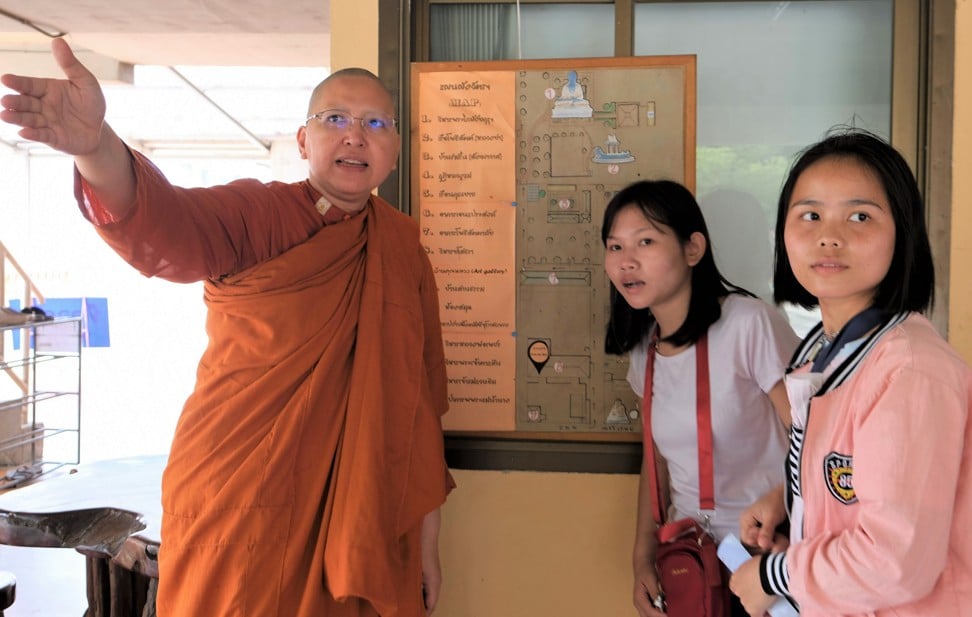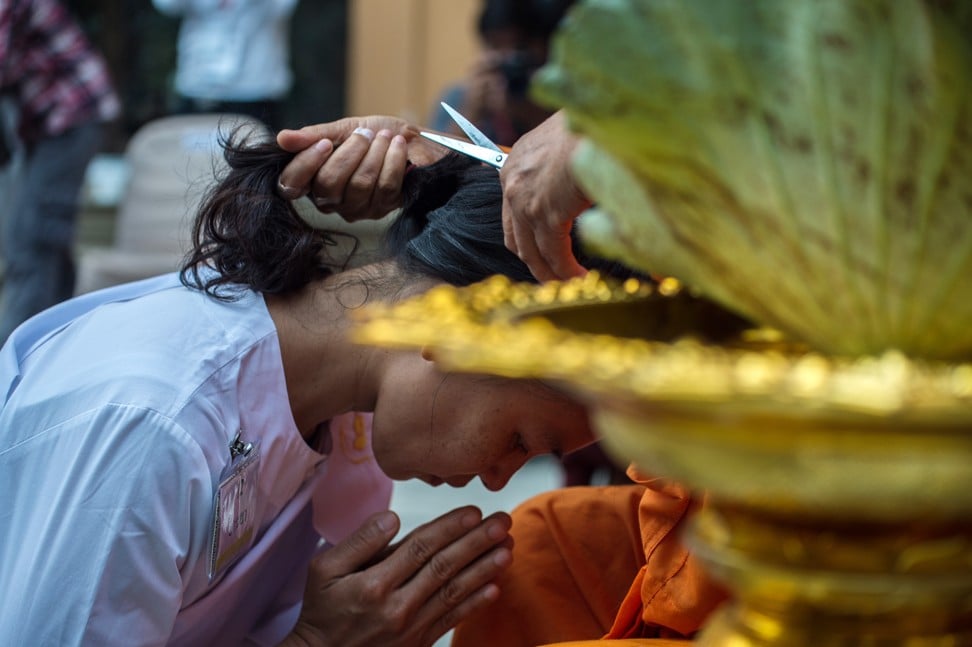
Thailand’s rebel female Buddhist monk on fighting sexism and her religion’s male monopoly
- Bhikkhuni Dhammananda, 75, helped ordain eight women monks in 2014, only for Thailand’s ruling Buddhist body to prohibit all future female ordinations
- She continues to ordain female Buddhist novices – about 800 now – and her own ordination in Sri Lanka has inspired almost 300 other female monks to do the same
Saffron-robed monks are a common sight across Thailand, collecting alms from the Buddhist faithful every morning, sitting cross-legged in temples, kneeling in prayer.
More than 99.9 per cent of them are men, and the nation’s Buddhist authorities are firm in their resolve to keep it that way.
It was the latest attempt by the all-male sangha, or Buddhist clergy, to ensure the monkhood remained a male monopoly under Thailand’s school of Theravada Buddhism.

In 1928, the council barred male monks from ordaining women after a Thai politician and Buddhist activist had his two daughters ordained, sparking a social uproar. For almost eight decades, that directive effectively blocked women from joining the monkhood. Then Dhammananda, who was born Chatsumarn Kabilsingh, came along and rocked the monastic boat.
Bhikkhuni is the word for female monks and they have been recognised in Sri Lanka since 1998. “I was the first female Theravada monk in Thailand,” Dhammananda, 75, says. “Now we have 285 female monks [mostly ordained in Sri Lanka]. They knew I was ordained in Sri Lanka, so they followed in my footsteps.”

Theravada is the oldest form of Buddhism and is widely practised in Thailand, Cambodia, Laos, Myanmar and Sri Lanka.
Thailand also boasts about 800 female Buddhist novices (samaneri), all ordained at Dhammananda’s Songdhammakalyani Monastery in Nakhon Pathom, about 50km (31 miles) west of Bangkok.
There are plans to ordain 42 more novices on December 5 – while the Sangha Supreme Council’s 2014 ruling prohibits the ordination of female monks, it does not include the ordination of novices. Dhammananda has offered women “temporary samaneri ordination” since 2008, twice a year on April 6 and December 5.

“The novice is a short-term duration, only nine days,” Dhammananda says. “They are mostly working women, but they come to experience monastic life, maybe once in a lifetime, which they were never allowed to do before. But it is something women really sought.”
The monastery, an unostentatious complex on 1.4 hectares (3.4 acres), was founded by Dhammananda’s mother, Voramai Kabilsingh, also called Ta Tao Fa Tzu, who became Thailand’s first Mahayana Buddhism female monk in 1971 after she was ordained in Taiwan. Mahayana Buddhism has more followers in Korea, Japan, China and Taiwan.
Dhammananda put off joining the clergy until she turned 53 years old. Before shaving her head and donning the orange robes, she had been married and raised three sons, taught theology at Thailand’s prestigious Thammasat University in Bangkok, and hosted a popular television show focused on Buddhist issues.
She has been the abbess of Songdhammakalyani since her mother’s death at the age of 95 in 2003, and she has offered many Thai women the chance to experience monastic religious devotion.
Buddhism was revived in Sri Lanka, so if male monkhood can be revived by taking the lineage from other countries, why not female monks? And that’s what I did [in Thailand]
The Songdhammakalyani centre also offers three-day primers in Buddhism (popular among foreign students) in May, June and July, organises prison visits, has a separate temple dedicated to the Medicine Buddha (a blue-hued deity popular in Tibet), and contains a library of Thai and English language literature on Buddhism.
Before Dhammananda came along, Thai women could only become nuns, or “mae ji”, religious figures who do not receive the societal respect afforded monks.
According to traditional monastic rules, female monks can only be ordained by both male and female monks from “unbroken lineages” – that is, from countries where Buddhism has been around since the Buddha’s time. The monkhood survived in Sri Lanka in part because practising monks were brought in from Myanmar to provide ordinations.
“Buddhism was revived in Sri Lanka, so if male monkhood can be revived by taking the lineage from other countries, why not female monks? And that’s what I did [in Thailand],” Dhammananda says of her controversial ordination in Sri Lanka.

With other women following her into the monkhood by way of Sri Lanka, there were eventually sufficient numbers of bhikkhunis in Thailand for them to ordain other female monks. Yet they were stymied – they could not persuade any Thai male monks to join the ritual because of the 1928 sangha council prohibition.
In 2014, Dhammananda got around the 1928 edict by inviting Sri Lankan male monks to take part in the ordination of eight women. The tactic clearly annoyed the Thai council and they issued the new prohibition against female ordination later that year.
“They try to stop us in all ways but we always find ways to do things,” Dhammananda says with a serene smile.
Despite the ongoing resistance from the sangha council, Thailand now has 285 bhikkhunis (mostly ordained in Sri Lanka), more than 800 novices (ordained in Thailand) and followers in 30 of Thailand’s 77 provinces.
They cracked down on her but she has survived. She has a lot of support from abroad, and a lot of Thai women support her here
The growth of Dhammananda’s female monastic movement comes at a time when the Buddha’s message of anti-materialism and selflessness is arguably lost on most Thais today.
“We [Thais] remain essentially Buddhist, but [genuine Buddhists] are only in very small pockets,” Sulak adds, citing Dhammananda’s movement as one of the few “positive” developments on Thailand’s Buddhism front.

Thailand has had its fair share of monastic scandals in recent years. Newspapers publish stories almost weekly about errant monks sexually abusing female worshippers or boy novices, getting involved in money scams, and flaunting an extravagant lifestyle.
Two rival offshoot Buddhist sects – the Dhammakaya and Santi Asoke – have prompted headlines over the past decade with their extreme views (Dhammakaya is pro-capitalism while Santi Asoke is anti-materialistic). Their increasing involvement in Thailand’s divisive and often violent politics has left many mainstream Buddhist followers bewildered and disillusioned.
Dhammaranda’s female monastic movement is outside the mainstream Buddhism system in Thailand, and so beyond the control of the Sangha Supreme Council.
“We would prefer not to come under them [the council] because they have enough problems already handling their 300,000 male monks,” Dhammananda says. “We would prefer the government to recognise us as female monks and allow us to do what we do.”
This is a sentiment shared by some of Thailand’s freethinking male monks, who likewise often run up against the council’s conservative, hierarchical constraints.
“Intellectual monks, when they return to the temples from universities where they have studied, have no power and the things that they propose are rejected,” says Ratha Vayagool, a monk and self-described “independent spiritual advisor”.
Most male monks are far from independent, and live directly under the control of their temple’s abbot.
“The abbot has the absolute power and if you don’t do what the abbot says you can be asked to leave, and then you must transfer to another temple. But if the abbot refuses to sign your transfer it’s very difficult to be accepted by another temple,” says Ratha, 50, who was educated abroad.
Like many well-educated, liberal-minded monks in Thailand, Ratha has learned to keep a low profile.
“Why? Because if the mainstream [establishment] cracks down they could knock us all down,” Ratha says.
He includes Dhammananda among the select few monks he supports. “They cracked down on her but she has survived,” he says. “She has a lot of support from abroad, and a lot of Thai women support her here.”
